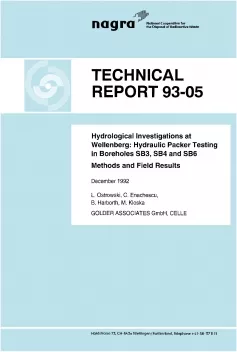
Technical Report NTB 93-05
Hydrological Investigations at Wellenberg:Hydraulic Packer Testing in Boreholes SB3, SB4 and SB6Methods and Field Results
The Wellenberg site in the Canton of Nidwalden, Central Switzerland, is being investigated as a potential location for the disposal of radioactive waste. Five deep boreholes were drilled at the site. This report describes hydraulic packer testing conducted in three of these boreholes (SB3, SB4 and SB6) between June 1990 and December 1991.
A total of sixty-three single and double packer tests were conducted and analyzed. The principal objectives of the tests were the measurement of the formation equivalent freshwater head and the hydraulic conductivity. Fourteen of the tests were designed and conducted principally for groundwater sampling. The tests were designed, conducted and interpreted taking account of the anticipated presence of methane gas within the rock at the site.
The equipment used for the testing included a Baker/Lynes Hydrological Test Tool. A Moyno pump was used as the principal downhole production system, and Grundfos and Shimadzu pumps for injection. Liquid-gas separation equipment was used for withdrawal tests because of the anticipated presence of methane. A flow control and metering system was provided, and this was linked to a computer-based data acquisition system.
Data analyses were performed using the standard pressure transient interpretation software Interpret and Interpret/2. Special attention was paid to the application of constant rate analysis for the interpretation of constant pressure events and of discontinuous events such as slug and pulse tests. The low hydraulic conductivity conditions found at the site can result in ambiguities in test interpretation. In order to estimate the range of possible errors, sensitivity analyses were conducted for selected test sequences. These investigated the influence on the analysis results of borehole pressure history and of the input parameters.
Preliminary analyses were conducted for all tested intervals. Detailed interpretations were made for twenty-eight selected intervals and documented in stand-alone reports. The results of both types of analysis are included in this report. Representative data, analyses and results for all the tests performed are compiled in the Appendix.
Interpreted hydraulic conductivities range from 10-13 m/s to 10-7 m/s for the Valanginian Marl. Higher hydraulic conductivities, of the order of 10-6 m/s, were measured in the upper parts of boreholes SB3 and SB4, partly in the marl and in the Rutschmasse formation. Artesian conditions prevailed in the upper section of all the boreholes and in the lowest part of borehole SB3. In boreholes SB3 and SB4 there were large zones with equivalent freshwater heads of several hundred metres below ground level. The presence of gas in the Valanginian Marl was confirmed, but the quantities were much smaller than expected.
